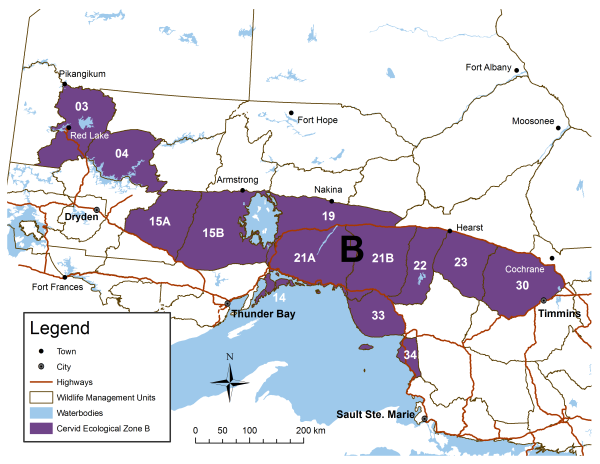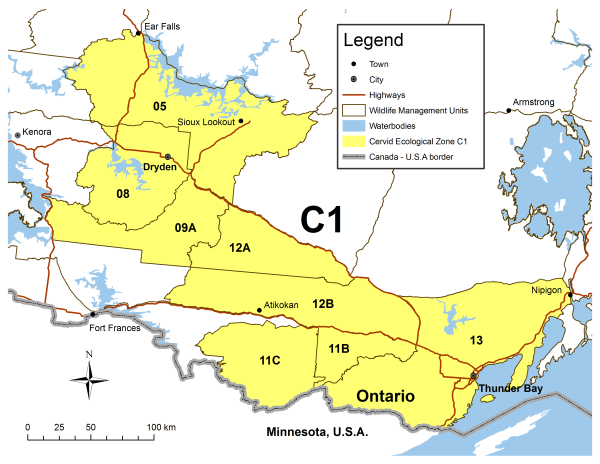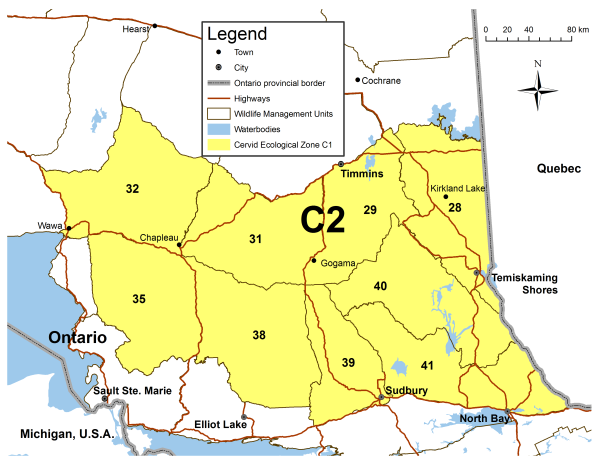Moose population management
Learn how aerial inventories, hunter reporting and trends are used to guide moose population management in Ontario.
The ministry tracks moose population trends through:
- aerial inventory survey results
- moose population objectives
- hunter reporting data
- estimated trends in other factors, such as winter ticks and brain worm
The combined results of these measurements are used to set the numbers of moose tags available in the annual moose tag allocation process.
Moose aerial inventories
- Moose aerial inventories are designed to provide estimates of the moose populations in Ontario’s wildlife management units (WMUs). This includes documenting the age class (calf or adult) and sex of moose in these areas.
- For the moose aerial inventories, most WMU are divided into rectangular plots measuring 10 kilometres x 2.5 kilometres and up to 40 or more plots are flown per WMU.
- The ministry aims to systematically survey each WMU where moose are hunted.
- Surveys are flown:
- between December 1 and mid-February, from 10 a.m. to 2 p.m.
- within 12 to 72 hours of a fresh snowfall (at least 30 cm) to better see moose or their tracks
- when the weather is colder than -5ºC, when moose are more likely to be active
- at about 140 metres above ground level, at close to 145 km/hour
- when the wind is less than 20 km/hour and the sky provides adequate visibility
Moose hunter reporting
Hunter activity and harvest reports are submitted by moose hunters across the province. New rules that took effect January 1, 2019 require all provincially licensed moose hunters to report on their activity and harvest.
The results of previous moose hunter activity and harvest reports can be found in the data on Moose hunting activity and harvests.
Trends in climate and parasites
The ministry uses modeling as well as research and monitoring projects to assess the impact of the wide range of factors that are putting pressure on moose.
Moose population objectives
Cervid Ecological Zone A
Woodland caribou, with low densities of moose and white-tailed deer, live in this zone. For both moose and white-tailed deer, the goal is to maintain low densities through population and habitat management.

| Cervid Ecological Zone | Wildlife Management Unit | 2025 Population Estimate | 2030 Population Objective - Lower | 2030 Population Objective - Upper |
|---|---|---|---|---|
| A | 1A | 352 | 250 | 400 |
| A | 1C | 6638 | 3900 | 9700 |
| A | 1D | 2990 | 2400 | 3600 |
| A | 2 | 1268 | 900 | 1200 |
| A | 16A | 1733 | 600 | 1500 |
| A | 16B | 1359 | 550 | 1100 |
| A | 16C | 1364 | 950 | 1300 |
| A | 17 | 927 | 900 | 2000 |
| A | 18A | 346 | 800 | 1100 |
| A | 18B | 278 | 300 | 450 |
| A | 24 | 1307 | 900 | 1800 |
| A | 25 | 728 | 800 | 1800 |
| A | 26 | 1115 | 1200 | 1600 |
| A | 27 | 769 | 650 | 1000 |
Cervid Ecological Zone B
Moose, white-tailed deer and woodland caribou live in this zone. For moose, the goal is to maintain a low to moderate density population.

| Cervid Ecological Zone | Wildlife Management Unit | 2025 Population Estimate | 2030 Population Objective - Lower | 2030 Population Objective - Upper |
|---|---|---|---|---|
| B | 3 | 2202 | 1900 | 2500 |
| B | 4 | 2218 | 1600 | 2200 |
| B | 14 | 274 | 450 | 650 |
| B | 15A | 2873 | 1800 | 3100 |
| B | 15B | 4967 | 3400 | 4600 |
| B | 19 | 1433 | 1300 | 1700 |
| B | 21A | 1993 | 2800 | 3800 |
| B | 21B | 1888 | 2400 | 3100 |
| B | 22 | 1091 | 1700 | 2100 |
| B | 23 | 1755 | 1400 | 2000 |
| B | 30 | 2412 | 1700 | 2300 |
| B | 33 | 684 | 900 | 1200 |
| B | 34 | 456 | 500 | 600 |
Cervid Ecological Zone C1
Moose and white-tailed deer are the main cervid species in this zone, but there may also be small numbers of elk and woodland caribou. For moose, the goal is to maintain a moderate to high density population.

| Cervid Ecological Zone | Wildlife Management Unit | 2025 Population Estimate | 2030 Population Objective - Lower | 2030 Population Objective - Upper |
|---|---|---|---|---|
| C1 | 5 | 2859 | 3300 | 3900 |
| C1 | 8 | 910 | 950 | 2400 |
| C1 | 9A | 989 | 1300 | 1700 |
| C1 | 11B | 514 | 600 | 850 |
| C1 | 12A | 1204 | 1200 | 1500 |
| C1 | 12B | 1902 | 2000 | 2500 |
| C1 | 13 | 1699 | 3300 | 4400 |
Cervid Ecological Zone C2
Moose and white-tailed deer are the main cervid species in this zone, but there may also be small numbers of elk and woodland caribou. For moose, the goal is to maintain a moderate to high density population.

| Cervid Ecological Zone | Wildlife Management Unit | 2025 Population Estimate | 2030 Population Objective - Lower | 2030 Population Objective - Upper |
|---|---|---|---|---|
| C2 | 28 | 2194 | 2300 | 3200 |
| C2 | 29 | 1956 | 1800 | 2200 |
| C2 | 31 | 2077 | 2100 | 3200 |
| C2 | 32 | 1161 | 1100 | 1600 |
| C2 | 35 | 2191 | 1900 | 2500 |
| C2 | 38 | 2445 | 2300 | 2800 |
| C2 | 39 | 1760 | 1400 | 1800 |
| C2 | 40 | 2000 | 1900 | 2800 |
| C2 | 41 | 2835 | 2600 | 3500 |
Cervid Ecological Zone D1
Moose, white-tailed deer and elk live in this zone. For moose, the goal is to maintain a moderate to high density population.
| Cervid Ecological Zone | Wildlife Management Unit | 2025 Population Estimate | 2030 Population Objective - Lower | 2030 Population Objective - Upper |
|---|---|---|---|---|
| D1 | 6 | 877 | 500 | 1400 |
| D1 | 7A | 33 | 75 | 200 |
| D1 | 7B | 888 | 400 | 1100 |
| D1 | 9B | 716 | 700 | 1000 |
| D1 | 11A | 841 | 550 | 850 |
Cervid Ecological Zone D2
Moose, white-tailed deer and elk live in this zone. For moose, the goal is to maintain a moderate to high density population.
| Cervid Ecological Zone | Wildlife Management Unit | 2025 Population Estimate | 2030 Population Objective - Lower | 2030 Population Objective - Upper |
|---|---|---|---|---|
| D2 | 36 | 1240 | 1200 | 1500 |
| D2 | 37 | 885 | 1100 | 1400 |
| D2 | 42 | 1747 | 1700 | 2300 |
| D2 | 46 | 360 | 350 | 1300 |
| D2 | 47 | 1046 | 900 | 1200 |
| D2 | 48 | 1398 | 600 | 1400 |
| D2 | 49 | 888 | 700 | 1500 |
| D2 | 50 | 733 | 300 | 800 |
| D2 | 53 | 139 | 250 | 1000 |
| D2 | 54 | 326 | 400 | 800 |
| D2 | 55A | 208 | 250 | 400 |
| D2 | 55B | 201 | 50 | 250 |
| D2 | 56 | 268 | 350 | 700 |
| D2 | 57 | 242 | 200 | 500 |
| D2 | 58 | 102 | 50 | 100 |
| D2 | 60 | 697 | 400 | 700 |
| D2 | 61 | 249 | 200 | 400 |
| D2 | 62 | 118 | 50 | 100 |
| D2 | 63 | 210 | 100 | 450 |
Cervid Ecological Zone E1, E2 and E3
White-tailed deer is the main cervid species living in this zone, but there are also small numbers of moose and elk. Moose are managed for low population densities in some parts of the zone.

| Cervid Ecological Zone | Wildlife Management Unit | 2025 Population Estimate | 2030 Population Objective - Lower | 2030 Population Objective - Upper |
|---|---|---|---|---|
| E3 | 59 | 5 | 10 | 25 |
| E3 | 65 | 128 | 75 | 150 |

